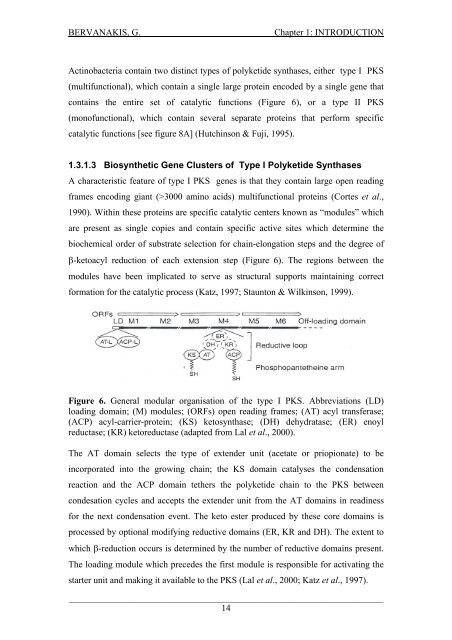Detection and Expression of Biosynthetic Genes in Actinobacteria ...
Detection and Expression of Biosynthetic Genes in Actinobacteria ...
Detection and Expression of Biosynthetic Genes in Actinobacteria ...
You also want an ePaper? Increase the reach of your titles
YUMPU automatically turns print PDFs into web optimized ePapers that Google loves.
BERVANAKIS, G.Chapter 1: INTRODUCTIONAct<strong>in</strong>obacteria conta<strong>in</strong> two dist<strong>in</strong>ct types <strong>of</strong> polyketide synthases, either type I PKS(multifunctional), which conta<strong>in</strong> a s<strong>in</strong>gle large prote<strong>in</strong> encoded by a s<strong>in</strong>gle gene thatconta<strong>in</strong>s the entire set <strong>of</strong> catalytic functions (Figure 6), or a type II PKS(mon<strong>of</strong>unctional), which conta<strong>in</strong> several separate prote<strong>in</strong>s that perform specificcatalytic functions [see figure 8A] (Hutch<strong>in</strong>son & Fuji, 1995).1.3.1.3 <strong>Biosynthetic</strong> Gene Clusters <strong>of</strong> Type I Polyketide SynthasesA characteristic feature <strong>of</strong> type I PKS genes is that they conta<strong>in</strong> large open read<strong>in</strong>gframes encod<strong>in</strong>g giant (>3000 am<strong>in</strong>o acids) multifunctional prote<strong>in</strong>s (Cortes et al.,1990). With<strong>in</strong> these prote<strong>in</strong>s are specific catalytic centers known as “modules” whichare present as s<strong>in</strong>gle copies <strong>and</strong> conta<strong>in</strong> specific active sites which determ<strong>in</strong>e thebiochemical order <strong>of</strong> substrate selection for cha<strong>in</strong>-elongation steps <strong>and</strong> the degree <strong>of</strong>β-ketoacyl reduction <strong>of</strong> each extension step (Figure 6). The regions between themodules have been implicated to serve as structural supports ma<strong>in</strong>ta<strong>in</strong><strong>in</strong>g correctformation for the catalytic process (Katz, 1997; Staunton & Wilk<strong>in</strong>son, 1999).Figure 6. General modular organisation <strong>of</strong> the type I PKS. Abbreviations (LD)load<strong>in</strong>g doma<strong>in</strong>; (M) modules; (ORFs) open read<strong>in</strong>g frames; (AT) acyl transferase;(ACP) acyl-carrier-prote<strong>in</strong>; (KS) ketosynthase; (DH) dehydratase; (ER) enoylreductase; (KR) ketoreductase (adapted from Lal et al., 2000).The AT doma<strong>in</strong> selects the type <strong>of</strong> extender unit (acetate or priopionate) to be<strong>in</strong>corporated <strong>in</strong>to the grow<strong>in</strong>g cha<strong>in</strong>; the KS doma<strong>in</strong> catalyses the condensationreaction <strong>and</strong> the ACP doma<strong>in</strong> tethers the polyketide cha<strong>in</strong> to the PKS betweencondesation cycles <strong>and</strong> accepts the extender unit from the AT doma<strong>in</strong>s <strong>in</strong> read<strong>in</strong>essfor the next condensation event. The keto ester produced by these core doma<strong>in</strong>s isprocessed by optional modify<strong>in</strong>g reductive doma<strong>in</strong>s (ER, KR <strong>and</strong> DH). The extent towhich β-reduction occurs is determ<strong>in</strong>ed by the number <strong>of</strong> reductive doma<strong>in</strong>s present.The load<strong>in</strong>g module which precedes the first module is responsible for activat<strong>in</strong>g thestarter unit <strong>and</strong> mak<strong>in</strong>g it available to the PKS (Lal et al., 2000; Katz et al., 1997)._____________________________________________________________________14















